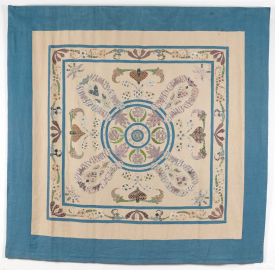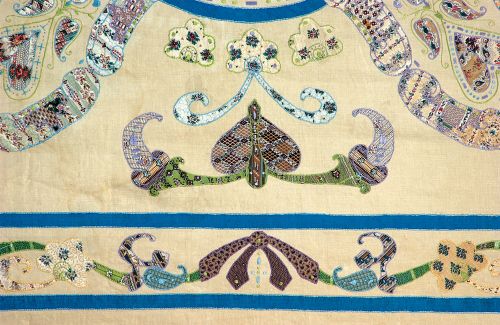August Quilt of the Month - The Ladies Work Society Coverlet
Published: Wednesday, 1st August 2012 00:10 AM

This stunning appliqué coverlet was purchased by The Quilters’ Guild in 1998, and is very different in style, quality and social background to any other applied pieces in the Collection. The coverlet has been studied in detail by Bridget Long of the British Quilt Studies Group, and her full article, ‘A Study of a Late Nineteenth Century Coverlet’ is available to read in Quilt Studies, The Journal of The British Quilt Study Group, Issue 3, 2001.
Design and Fabrics
The coverlet is made from a background of blue and off-white linen, with appliqué motifs of good quality printed cotton dress fabrics, which are mainly floral designs in light and dark mauve, blue, red and green. The sophisticated appliqué design consists of four central circles with floral and circular motifs, which also appear further outside the centre along with Paisley Pears and Heart motifs. The outer edges of the coverlet follows a frame design in contrasting blue and off-white linen, and the appliqué motifs are couched over the joining edges with embroidery silks. The centre circle of the quilt contains the embroidered word ‘INDUSTRIA’ in satin stitch - a hint towards the women’s society who made the quilt and the values behind it.
An Arts and Crafts Ethos
The design and workmanship on this coverlet is of an excellent standard, and the use of printed rather than plain cottons and the embroidered decoration sets the coverlet apart from other appliqué quilts from the 19th century. The appliqué style and embroidery points to its origins in the Arts and Crafts movement that was emerging at the end of the 19 thcentury. Led by artists and designers such as William Morris and Walter Crane, the movement aimed to promote and encourage architecture and the applied arts as worthy artistic disciplines, reacting against the established claims that only paintings and sculpture should be considered art. The movement aimed to raise the standards of design through collaborative partnerships between designers and craftsmen. They looked towards the past to copy traditional handcrafted techniques and skills, including areas such as embroidery, where skills and creativity had been slowly declining with the increasing popularity of sewing crazes such as Berlin Wool Work, which required simple stitches on a pre-printed canvas. Along with ladies’ embroidery societies and the Royal School of Art Needlework, the movement revived the interest in hand embroidery, encouraging more creativity and variety.
The Ladies Work Society
The Ladies Work Society was established by Princess Louise in 1875, and was intended to assist gentlewomen who found themselves in financial hardship in an era when there was little choice of a working profession. Taking on paid work, even in more acceptable positions such as governess or companion, meant a serious loss of social standing. The society therefore gave these women suitable ‘Art work’, which built upon the standard needlework skills inherent in all female education, and raised their standards to a professional level. The Society had its headquarters at 31 Sloane Street in London - a woven label on the back of this coverlet with this address is still intact. The headquarters would take in orders for embroidery and clothes, which would then be sent out to the society members who would work from home.
The Society became known for its excellent standards, and they also exhibited their work in many exhibitions, including the Arts and Crafts Exhibition in 1890 and World Trade Exhibitions in Paris and Canada. The unusual design and quality of this coverlet could indicate that it was made for an exhibition rather than for a standard domestic order, but there is no evidence to support this in existing catalogues and archives.. The Ladies Work Society still exists today, and continues to provide a high quality service to customers world-wide.
 Ladies Work Society Coverlet
Ladies Work Society Coverlet
 Close up detail of the applique on The Ladies Work Society Coverlet
Close up detail of the applique on The Ladies Work Society Coverlet